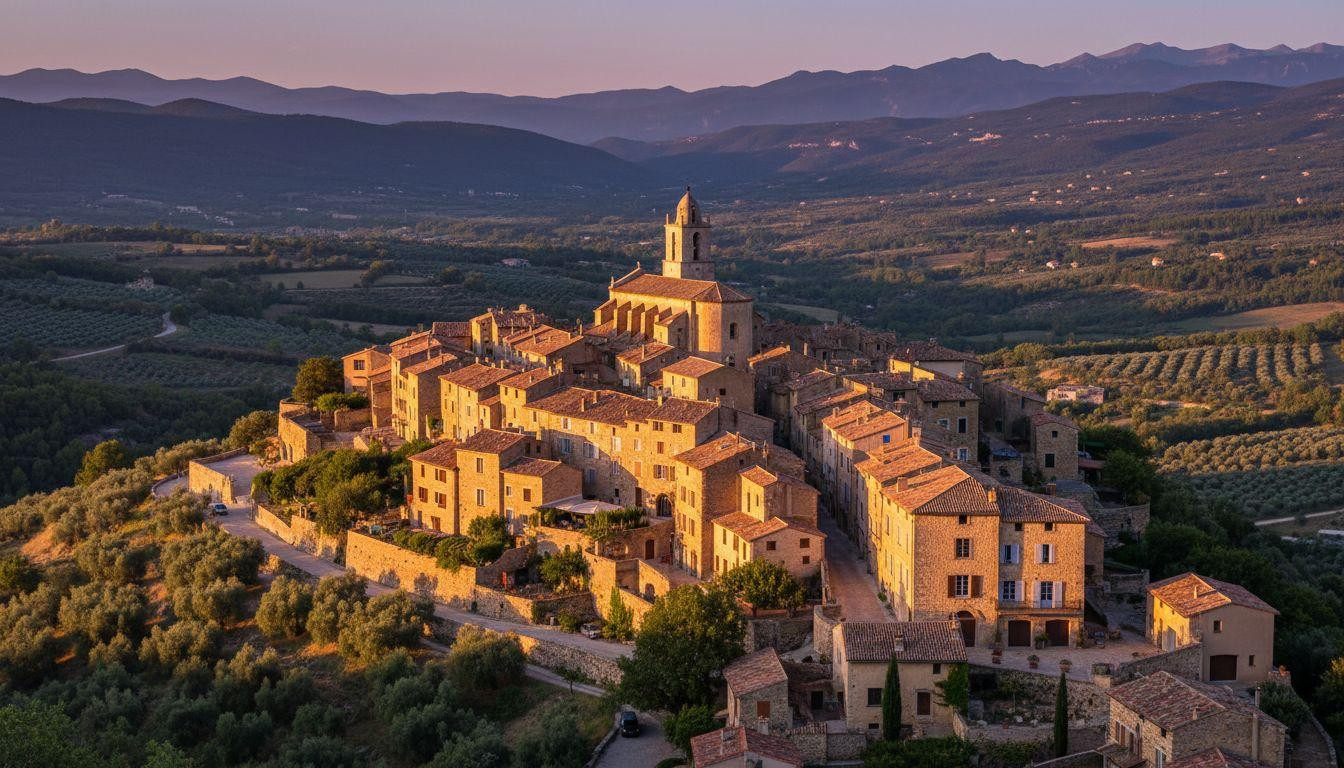Dawn breaks at 6:47 AM in Fayence’s upper village, casting honey-colored light across limestone facades. Steam rises from morning coffee at terrace cafés while the Massif des Maures mountains glow purple across empty valleys. This isn’t the Côte d’Azur’s glittering coast 43 miles away, where millions crowd Cannes and Nice. This is Provence’s quieter truth: perched villages, olive groves, and authentic rhythms that persist 1.5 hours inland. While coastal resorts charge $220+ nightly in peak season, Fayence offers $55-165 accommodations, Saturday market rituals unchanged for generations, and 360-degree mountain vistas without the selfie sticks.
Where golden stone meets mountain sky in Provence’s backcountry
Fayence anchors the Pays de Fayence region in Var’s inland plateau, positioned between the Massif des Maures to the south and Estérel ranges to the east. From Nice-Côte d’Azur Airport, the journey requires approximately 62 miles and 2 hours driving through elevation changes that transform coastal Mediterranean into highland Provence. The village occupies 604 feet elevation, creating natural temperature advantages: 7-9°F cooler than coastal cities in summer, making November’s 46-54°F comfortable for exploration.
The architectural palette follows Provençal tradition. Golden and ochre stone facades complement deep terracotta roof tiles. Narrow cobblestone streets designed for medieval defense wind through the village. Unlike heavily restored tourist villages, Fayence retains organic evolution: weathering, practical adaptation, and genuine residential life coexisting with visitor infrastructure.
The village that chose authenticity over tourism gold
What makes Fayence different from coastal Provence
The 18th-century church commands upper village elevation, offering sight lines extending toward both mountain ranges and valley agriculture below. The Four du Mitan (original communal oven constructed in 1522) functions as free daily museum, preserving tangible connection to centuries of shared bread-baking rhythms. Art galleries and artisan studios line streets not as tourist theater but as working creative economy: potters, painters, sculptors who migrated seeking affordable space and inspiration from surrounding landscape.
The light that transforms stone into gold
Late afternoon light activates mineral deposits in limestone facades, creating the characteristic Provençal amber glow photographers chase. This isn’t marketing hyperbole. Geological composition and low sun angles produce authentic color transformation lasting approximately 45 minutes before sunset. Olive groves dot hillsides in silver-green patterns, particularly visible from elevated vantage points where dramatic sight lines create classic atmospheric perspective: deep valleys, distant purple mountains, layered depth.
Living the Provençal rhythm tourists never experience
Saturday morning’s social ritual
Municipal outdoor sports club hosts weekly gatherings where residents and visitors convene informally. This represents genuine community engagement rather than staged tourism. The Saturday and Wednesday markets serve primarily local needs: fresh vegetables, herbs, cheese, baked goods, seasonal specialties. Producers sell directly; social exchange happens naturally; practical shopping occurs alongside casual conversation. Similar authentic market traditions flourish in nearby villages, creating regional networks of authentic Provençal life.
The true cost of Provence without coastal markup
Off-season accommodations (November-March) range $55-88 budget properties, $99-165 mid-range options. This represents 30-40% savings versus peak season and significant discounts compared to coastal equivalents. Simple café lunch costs $13-20; mid-range dinner $28-44. Local wines purchased from producers run $9-28 per bottle versus restaurant markups. The EcoMusée du Pays de Fayence documents historical agricultural practices free of charge, while surrounding villages offer walking exploration without admission fees.
Why this village feels like time moves differently
The Mediterranean lunch rhythm persists here: substantial 12-2pm break when businesses close, evening paseo as preferred social activity, seasonal adjustments to tourism intensity. Visitors embracing rather than resisting these rhythms experience place authentically. The cumulative effect (medieval architecture, surrounding landscape, manageable scale, artistic community, culinary traditions, resistance to commercial homogenization) creates what residents describe as “perfect place to unwind and recharge.” This extends beyond simple pleasantness into existential appeal: human rhythms aligned with natural cycles rather than commercial tourism acceleration.
While Catalan villages offer similar sunset phenomena, Fayence’s unique position creates year-round appeal without extreme seasonal variations.
Your questions about Fayence’s hidden Provence answered
How do I actually get to Fayence from major cities?
Fly into Nice-Côte d’Azur Airport (62 miles, approximately 2 hours by car). Rent vehicle for inland exploration. Train connections exist via Cannes or Saint-Raphaël but require final car rental or private transfer. Village streets accommodate European-standard vehicles better than large SUVs. Driving involves narrow medieval streets (one-way sections), tight parking, elevation changes. Budget $11-22 for highway tolls. This transportation reality naturally filters visitors toward independent travelers comfortable with driving.
What’s the best season for avoiding crowds?
November-March offers 30-40% accommodation discounts, near-absence of tourist infrastructure stress, and authentic village atmosphere. April-May provides optimal conditions: mild temperatures (50-61°F), manageable crowds, dramatic light, wildflower countryside. July-August brings busloads of coastal day-trippers and peak pricing despite cooler elevation temperatures than coast. Northern alternatives like Normandy villages offer similar seasonal patterns with different regional character.
How does Fayence compare to Gordes or Roussillon?
Gordes draws significantly higher tourist volumes and commercial development. Fayence maintains working village character: artisan studios function as creative economy, not staged attractions. Costs run 20-30% lower than famous Luberon villages. The trade-off: less international recognition means fewer English-language services but more authentic immersion in Provençal daily life. Similar value propositions exist globally, where proximity to famous destinations creates affordable authentic alternatives.
At 5:47 PM in November, low sun transforms limestone into amber gold above valley olive groves. Steam rises from evening café tables while residents begin paseo through narrow streets. The coastal crowds remain 43 miles distant. Here, Provence still breathes at human pace, unchanged by Instagram’s discovery algorithms.
